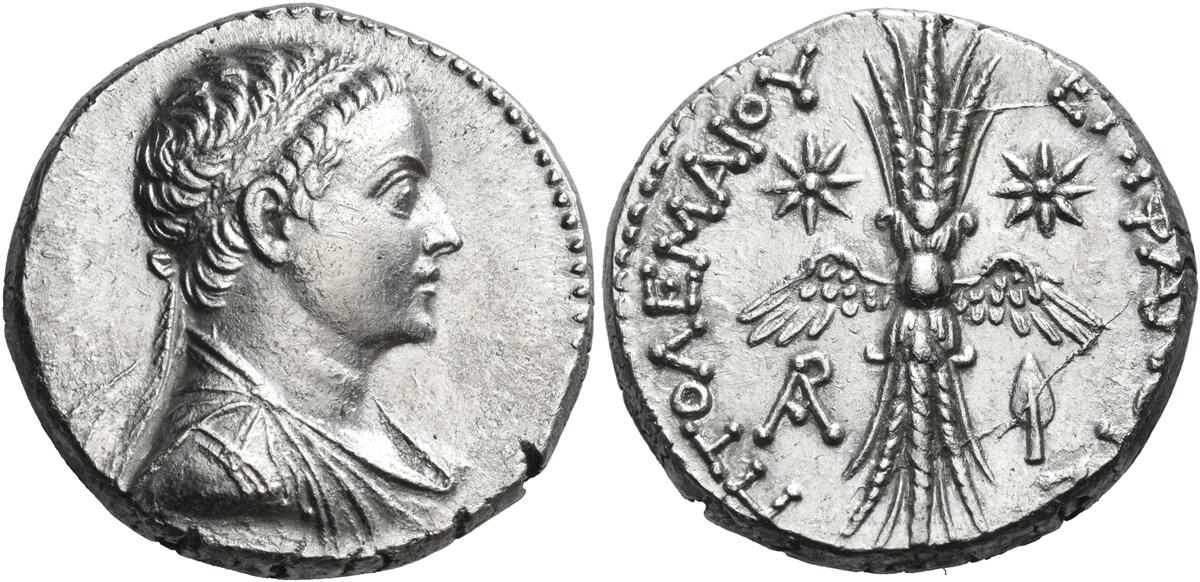S 2043 - Alexandria (Ptolemy V), silver, tetradrachms (thunderbolt) (199-198 BCE)
From SILVER
199 BCE - 198 BCE Silver 589 kg
Description
| ObverseInscription or printing placed on the obverse.: | Draped bust of the youthful Ptolemy Epiphanes to right, wearing diadem ornamented with a laurel wreath |
| ReverseInscription or printing placed on the reverse.: | ΠΤΟΛΕΜΑΙΟΥ ΕΠΙΦΑΝΟΥΣ (Greek).Winged thunderbolt, above the wings to left and right, 8-rayed star, in the field below the wings to left, monogram of ΑΡ, in the field to right, spearhead upwards |
Mint and issuing power
| MintIdentifies the place of manufacture or issue of a numismatic object.: | Alexandria | Ancient regionAncient region.: | Egypt | Modern countryModern country: Egypt | AuthorityIdentifies the issuing power. The authority can be "pretended" when the name or the portrait of X is on the coin but he/she was not the issuing power. It can also be "uncertain" when there is no mention of X on the coin but he/she was the issuing power according to the historical sources: | Ptolemaic dynasty (323-30 BC), Ptolemy V Epiphanes (Ptolemaic king, 204-181 BC) |
Chronology
| FromIdentifies the initial date in a range assigned in a numismatic context. | 199 BCE | toIdentifies the final date in a range assigned in a numismatic context.. | 198 BCE | PeriodTime period of the numismatic object.: Hellenistic 323-30 BC |
Physical description
| MetalThe physical material (usually metal) from which an object is made.: | Silver |
Median weightMedian of the weights of numismatic objects (in grams). in grams | 14.10 | DenominationTerm indicating the value of a numismatic object. Examples: tetradrachm, chalkous, denarius.: | tetradrachm |
StandardStandard.: | Attic |
Image

S2043 Ptolemy V thunderbolt.jpg [1]
References
| Die study referencePublication of the study: | Carlen 20191Carlen 2019, p. 106 | ||
| Coin series referenceReference to coin series study: | Sear II2Sear II, n° 7865 | ||
Obverse dies distribution
| FrequencyFrequency of specimen in distribution. ᵖ | Number of obversesNumber of obverse dies. ᵖ (o) | % (o) | Number of coinsNumber of coins. (n) | % (n) | Die nameName(s) of the die(s). |
| 7 | 1 | 50 | 7 | 46.67 | 7 |
| 8 | 1 | 50 | 8 | 53.33 | 8 |
| Total | 2 of 2 | 100 | 15 of 15 | 100 |
Reverse dies distribution
no distribution is available
Quantification
| Number of obversesNumber of obverse dies. ᵖ (o) | 2 | Number of singletons (o1)The number of singleton coins. ᵖ | |
| Number of reverse diesNumber of reverse dies. (r) | 5 | Number of coinsNumber of coins. (n) | 15 |
| Coins per obverse dieNumber of coins per obverse die. (n/o) | 7.5 | Coins per reverse dieNumber of coins per reverse die. (n/r) | 3 |
| Reverse per obverse ratioRatio of obverse dies divided by reverse dies. (r/o) | 2.5 | Percentage of singletons (o1)number of coins (n) divided by the number of singletons (o1) ᵖ | % |
| Original number of dies (O) (Carter 1983 formula)The estimation of the number of coins according to Carter 1983 ᵖ | 2.09 | Coins struck if 20,000 as average productivity per dieCoins made if the average productivity for obverses (according to Carter) is 20,000. ᵖ | 41,800 |
| Original number of dies (O) (Esty 2011 formula)The estimation of the number of coins according to the singleton formula in Esty 2011 ᵖ (O) | 2.31 | Survival rate if 20,000 as average productivity per dieSurvival rate if average productivity is 20,000. ᵖ | 0.00036 |
| Coverage (o = % of O) (Esty 1984 formula)Esty 1984 - coverage (% of O) ᵖ (o = % of O) | % | Die productivity if survival rate 1/2,000Average productivity if survival rate is 1/2,000. ᵖ | 14,354.07 |
| Weight of silver (in kg) if 20,000 coins per die (O = Carter formula)Carter 1983 * Median weight * 20000 (*10 if gold or electrum) ᵖ | 589 kg <br /> 589 kg | Die productivity if survival rate 1/5,000Average productivity if survival rate is 1/5,000. ᵖ | 35,885.17 |
Remarks
Most likely one single workstation